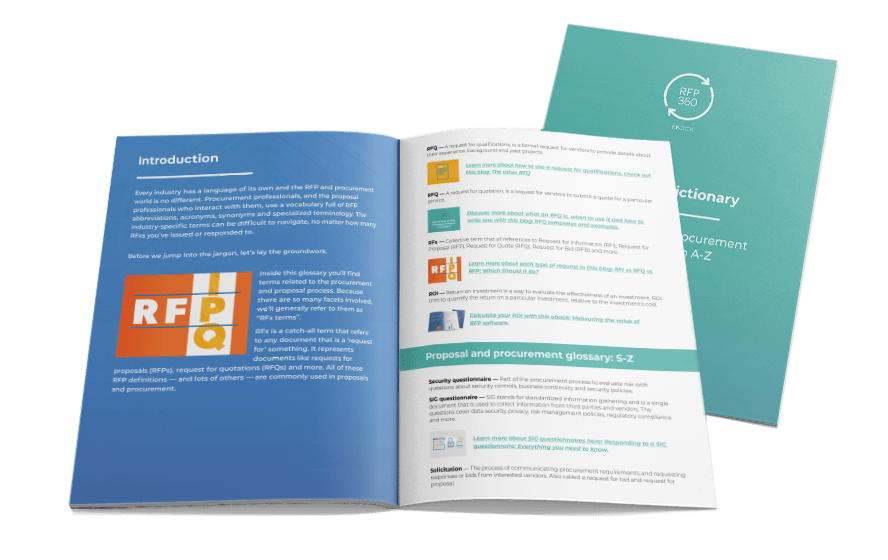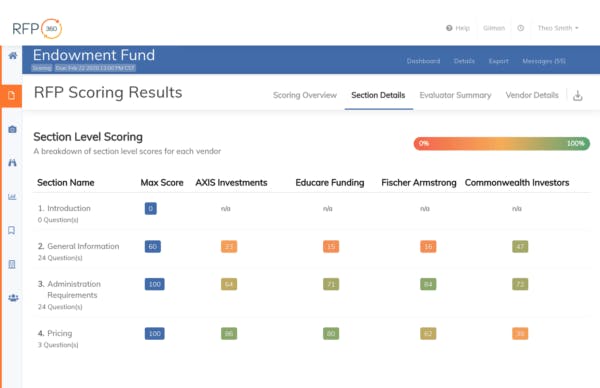Undoubtedly, one of the most challenging parts of running a successful request for proposal (RFP) is the vendor selection process. After all, selecting a vendor – not just any vendor, but the perfect vendor – is the whole purpose of issuing an RFP. Not to mention, by the time you’re ready to evaluate proposals, you’ve likely already invested an enormous amount of time and effort in the project. And, the future success of the procurement project depends on the results of your vendor selection process. So, for many RFP project managers, there’s a lot of pressure to get it right.
In this blog post, we’ll explore the ins and outs of vendor selection. I’ll offer a guide to the supplier selection process, advice for creating the RFP criteria and scorecard, as well as general vendor selection best practices. With this information, you’ll be well-equipped to confidently select the perfect partner.
What is vendor selection?
Vendor selection is the process through which businesses evaluate and choose the best vendor to meet their specific requirements. It often follows a structured approach, such as the Request for Proposal (RFP) process, culminating in the evaluation of prospective suppliers based on critical criteria like cost, quality, reliability, and service. This crucial step ensures organizations partner with the most suitable vendors to support their strategic goals and operational needs.
For more RFX, procurement and proposal definitions, check out this handy dictionary: The RFP glossary.

Vendor selection process overview
Admittedly, properly evaluating vendors takes time, but selecting the right supplier is worth it. As The Balance Small Business blog puts it,
“The main objective of the proposal evaluation and vendor selection phase is to minimize human emotion and political positioning in order to arrive at a decision that is in the best interest of the company.”
In order to create a consistent and successful supplier selection process, you must reduce the possibility of bias or a misunderstanding skewing the results. Accordingly, the vendor selection steps below will help create a clearer, more data-driven approach to selecting a supplier.
1. Gather your vendor selection criteria
Before you build an RFP scorecard or provide instruction for stakeholder scoring, reviewing some initial project documentation will help bring clarity to the evaluation process. Ideally, much of the necessary groundwork for vendor selection happened in earlier stages of the RFP process.
When it’s time to evaluate the proposals received, you’ll want to refer back to information from the requirements discovery step. Gather any notes and documentation you collected from stakeholder interviews and planning about the original goals and purpose of the RFP.
This is especially important when working with multiple scorers. It is crucial to keep everyone on the same page when it comes to goals, scope and budget. Here’s where you can find the most useful info:
Requirements discovery
The requirements discovery documentation should define the challenge to be solved, goals and proposed project information. The document should be a compilation of all the stakeholders’ needs and priorities. Having this information handy will remind the evaluation team of the original scope of the project — keeping them focused on needs instead of wants.
RFI results and vendor profiles
If you issued a request for information (RFI) or used vendor profiles to create a vendor shortlist prior to issuing the RFP you’ll want to have the responses available for reference. It can be helpful to compare the RFI results with the formal proposals you received. In addition, the RFI or vendor profile may provide additional context or information if you have two options that score very closely and you need a tie breaker to select a vendor.
Vendor selection criteria
Hopefully the RFP included your vendor selection criteria. If so, you’re already halfway to having your scoresheet ready. As you start to prepare your vendor selection scorecard, follow the established criteria as closely as possible.
Remember that vendors or suppliers generally spend more time preparing thoughtful solutions and answers to the sections that you indicate are most important. Subsequently, they should be weighted accordingly.
2. Create your proposal evaluation team
When it comes to picking the right supplier or vendor for a procurement project, it’s wise to welcome input from colleagues. For example, the stakeholders and executives who are most directly affected by the project’s outcome can provide a valuable perspective. Often, they can identify gaps in a solution’s offerings, see potential roadblocks, and offer additional insights and context around complicated RFP responses.
Bringing in additional reviewers to score the proposals also offers transparency to the selection process. Because stakeholders are involved in the final selection, this approach can speed adoption, create solution champions and help get detractors on board with change.
When selecting the evaluation team, define how each will be involved from the beginning. Will they be responsible for scoring, consulting or simply observing the process? Who will ultimately be responsible for a final determination if there’s a tie or disagreement?
It may be tempting to skip this step and assume everyone understands expectations, but we urge you not to. Often when the supplier selection process stalls, it’s because the roles and responsibilities weren’t clearly defined, so it’s not clear who will make the final decision. You may find a RACI matrix helpful for organizing the scoring team and keeping everyone on track.
3. Build your vendor selection scorecard
To make scoring easy for your evaluation team, create a vendor selection scorecard based on your vendor selection criteria. After you’ve created the scorecard that reflects the RFP questions, set the weights for each section. We highly recommend RFP weighted scoring as a way to prioritize the sections of the proposal that are most important to your business.
Most procurement teams use complicated Excel spreadsheets and formulas to manage vendor scoring. Certainly, you can use a vendor selection scorecard template to manually manage weighted scoring. While the process works, it also has some drawbacks. Vendor selection scoresheets managed in Excel often run into version control issues, broken formulas and unintended edits which makes compiling the results difficult and occasionally unreliable.
Download the vendor selection scorecard template (.xlsx)
On the other hand, RFP software offers an automated approach to the vendor selection scorecard. The platform allows you to centralize scoring, assign stakeholder scorers and review the results in helpful data visualizations.
Explore all the benefits and value that RFP management software delivers [ebook].
Much weighted scoring is done with complicated formulas in an Excel spreadsheet, but if you have RFP software, you’ll be able to do this step more collaboratively and you may even be able to automate some of the functionality. This is where RFP software really shines. When you’re looking for an apples-to-apples view of your options, RFP software makes it easy.

4. Score the proposals
Before you begin scoring RFPs to select your vendor, consider the best way to involve all the necessary parties. Will you have stakeholders score the entire proposal, or just the sections relevant to them? Or, will your stakeholders form departmental teams and score collectively?
In addition, will you be scoring blind or will evaluators know which company submitted which proposal? We recommend blind scoring if possible to avoid any unintentional personal bias of the scorers.
No matter which tool or process you use to score your proposals remember to provide clear guidance on how to score. This is especially important when you have more than two scorers. Everyone should understand what constitutes a good score. Use your requirements discovery to help create your score guidance.
5. Make your final supplier selection
You made it to the end of the process. Hopefully, if all went well, you’ll have a clear winner. However, the process isn’t always cut and dry. You may need to advance the top two or three vendors to a finalists list for further review or clarification.
If you need to continue the process, consider asking these supplier questions. And remember to follow up with vendors and provide progress updates. If you’re moving into a finalists process, update the vendors that didn’t make the cut and offer an RFP debrief. If it’s possible to provide feedback, don’t hesitate to offer insights about your decision.
Vendor selection best practices from the pros
We know that when it comes to vendor selection best practices, there’s no one better to ask our friends at Lockton’s HR Technology and Outsourcing Practice. Led by Brad Mandacina, they created a list of dos and don’ts for the vendor selection process. These tips will make it easier to select a supplier that’s a perfect fit and reduce some of the stress surrounding the process.
The dos and don’ts of the supplier selection process
Before you create your RFP:
DO: See if you can remedy any service or technology issues before committing to select a new vendor.
In most cases, it is usually cheaper and easier to fix current issues versus starting new with a different vendor.
DO: Fully define what is in scope for your selection.
This will help you understand your solution priorities and quickly weed out vendors that can’t meet your needs. We recommend having a collaborative session with your HR, IT and executives and asking all stakeholders to voice their needs and goals.
DO: Establish a budget prior to starting the vendor selection process.
It’s really important to have budget approval (and overall project approval) from your C-suite prior to starting the process. Pricing is all across the board with vendors, and you don’t want to get too far along and then find out the vendor is way out of your budget.
DO: Select a project manager or project lead.
This will be very important if/when issues arise, or for assigning responsibilities. Establishing stakeholders and a steering committee upfront is key to project success.
DO: Determine your critical decision factors – what is most important to you?
Your critical decision factors are going to ultimately drive your purchasing decision and could be any of the following: pricing model, specific functionality or features (automation, integration, reporting tools), customer experience, the vendor’s reputation, etc.
DO: Take time to research the vendors.
There are a ton of “HR technology” vendors in the market. Take the time to vet the functionality and service offerings of each vendor. Also, look at what customers have to say about their solutions or services.
As you create and issue your RFP:
DO: Be detailed and specific in your request for proposal.
An RFP that offers context, background details and specific requests helps you get the best pricing estimates and service offerings. When vendors know exactly what you are looking for and how your company works, they are able to determine if it’s a good fit and provide accurate pricing proposals.
DO: Make sure to ask the right questions in your RFP.
Develop questions that help determine if a vendor meets your needs and those critical decision factors we discussed earlier.
DO: Maintain communication with your key stakeholders and project team.
Keep the lines of communication open and flowing with anyone even remotely involved in the project. Remember to include your IT team in the communication as well. Most executives don’t like surprises and want to be well informed of the status of the project.
DO: See if you can remedy any service or technology issues with an existing vendor before committing to select a new one.
In most cases, it is usually cheaper and easier to fix current issues versus starting new with a different vendor.
DO: Ask for best and final pricing and service level agreements from your vendor during contract negotiation.
It never hurts to ask, right?
When you evaluate and select a supplier:
DO: Ask for best and final pricing and service level agreements from your vendor during contract negotiation.
It never hurts to ask, right?
DON’T: Sign the contract without reviewing it first.
Most contracts are for three years, some for one year minimum. That’s a long time and a lot of money. Have your legal team take a look at the contract and even attempt negotiations if something is questionable.
You have the right to redline and vendors expect you to give some pushback. Vendor contracts are generally written in their favor, so you need to make sure you are looking at it with your best interests in mind.
DON’T: Make a decision based on price alone.
Poor service is the biggest frustration most employers have with technology, not the price. Functionality and service are other big areas to consider before making your decision.
DON’T: Panic!
Take a deep breath. You can do it!
The HR Technology and Outsourcing Practice performs vendor selections and implementations for all technologies related to human resources, including benefits administration, payroll, time and attendance, HRIS, talent management (performance management, learning management, succession planning, compensation management and recruiting), ACA reporting and more.
The team provides a vast amount of industry experience, having worked with clients in industries such as healthcare, entertainment, manufacturing, financial, legal, retail and more. Employers can call on Brad and his teams’ combined experience in human resources and technology to help automate the business processes providing the foundation of their business.
More than 5,600 professionals at Lockton provide 48,000 clients around the world with risk management, insurance, employee benefits consulting and retirement services that improve their business. From its founding in 1966 in Kansas City, Missouri, Lockton has attracted entrepreneurial professionals who have driven its growth to become the largest privately held, independent insurance broker in the world and 10th largest overall.
An even easier vendor selection process
The vendor selection process requires an extensive amount of resources, time and personnel — for good reason. Selecting the right vendor the first time can create a significant savings for your business. Following vendor selection best practices and steps will improve your chances of making the right choice.

